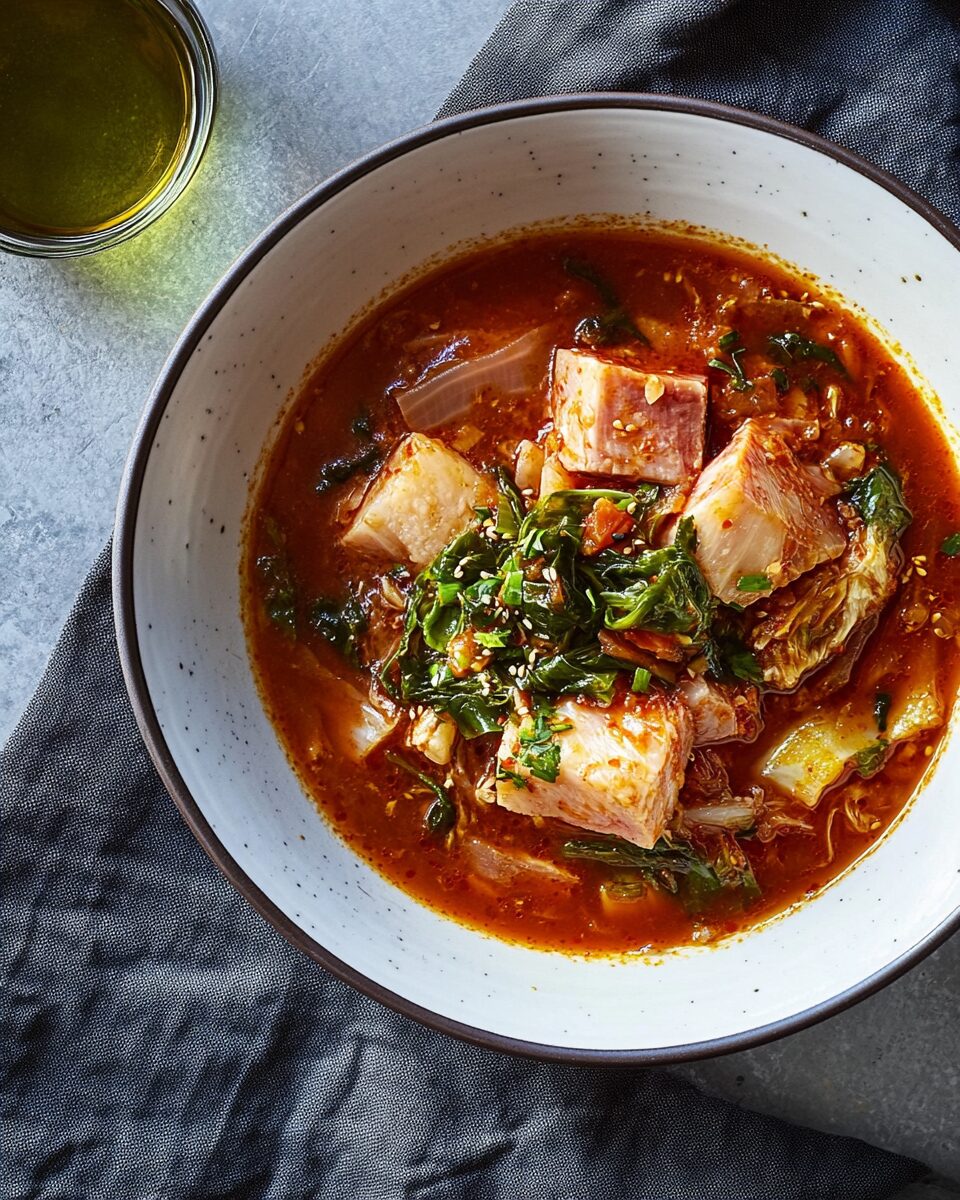Kimchi Stew with Pork Belly, known as Kimchi Jjigae, is a quintessential Korean comfort dish. This hearty stew combines the robust flavors of aged kimchi with tender pork belly, creating a spicy and savory meal that’s both warming and satisfying.
FULL RECIPE:
Ingredients
- 1 pound napa cabbage kimchi
- 1 medium onion, sliced (about 3/4 cup)
- 2 tablespoons Korean chili paste (gochujang)
- 2 teaspoons sugar
- 1 teaspoon salt
- 2 teaspoons toasted sesame oil
- 3 scallions, 2 sliced into 3-inch pieces, 1 chopped
- 2 1/2 cups water or kimchi brine
- 5 ounces pork belly, cut into bite-sized pieces
- 8 ounces medium-firm tofu, cut into bite-sized pieces
Directions
- In a large pot, combine the kimchi, onion, chili paste, sugar, salt, sesame oil, and the 3-inch pieces of scallions.
- Add the water or kimchi brine to the pot and bring to a simmer over medium heat. Cook for 25 minutes.
- Add the pork belly and tofu to the stew. Continue cooking for an additional 4 to 5 minutes, or until the tofu is soft and the pork is cooked through.
- Garnish with the chopped scallion before serving.
Nutrition Facts
- Calories: Approximately 344 kcal
- Fat: 33g
- Saturated Fat: 11g
- Cholesterol: 41mg
- Sodium: 21mg
- Potassium: 111mg
- Carbohydrates: 2g
- Fiber: 1g
- Sugar: 1g
- Protein: 10g
The Origins of Kimchi Stew
Kimchi Jjigae has a long history in Korean cuisine. Kimchi itself dates back over a thousand years and was traditionally made as a method of preserving vegetables for the winter months. The fermentation process gives kimchi its signature sourness and deep umami taste, which intensifies over time. Koreans found that using aged kimchi in soups and stews enhanced its flavor, leading to the creation of Kimchi Jjigae. This dish became a popular way to use leftover or over-fermented kimchi, ensuring that no food went to waste. Over time, families began adding various ingredients such as pork, tofu, and seafood, depending on personal preferences and regional variations. Today, kimchi stew is considered one of Korea’s most iconic and essential comfort foods.
Why Aged Kimchi is Essential
The key to making a truly flavorful Kimchi Jjigae is using well-fermented, aged kimchi rather than fresh kimchi. As kimchi ferments, it develops a more robust sourness and umami taste that enhances the overall depth of the stew. Fresh kimchi lacks the complexity needed for an authentic taste, making aged kimchi the preferred choice for this dish. Many Koreans purposefully set aside a portion of their kimchi for the sole purpose of making stews and soups once it reaches the perfect fermentation stage. Aged kimchi also releases its juices into the stew, contributing to the broth’s richness. The fermentation process creates naturally occurring probiotics, which are beneficial for gut health. So not only does aged kimchi enhance the flavor, but it also provides health benefits, making Kimchi Jjigae a nutritious choice.
The Role of Pork Belly in the Dish
Pork belly is one of the most commonly used proteins in Kimchi Jjigae, and for a good reason. The fat content in pork belly melts into the stew as it simmers, creating a deep, savory richness that balances the tangy and spicy notes of the kimchi. The combination of tender, juicy pork with the bold flavors of kimchi results in an incredibly satisfying dish. While some people may opt for leaner cuts of pork or even substitute it with beef or canned tuna, pork belly remains the most traditional and popular option. The rendered fat from the pork belly enhances the broth’s texture and flavor, making it velvety and full-bodied. This richness is what sets pork belly kimchi stew apart from other variations.
Health Benefits of Kimchi Stew
Despite its indulgent flavors, Kimchi Jjigae offers several health benefits due to its nutritious ingredients. Kimchi itself is a probiotic-rich food that supports digestion and gut health. The fermentation process creates beneficial bacteria that promote a healthy microbiome, which has been linked to improved immune function and digestion. Pork belly, while rich in fat, also provides essential proteins and nutrients, including B vitamins, iron, and zinc. When consumed in moderation, it contributes to a balanced diet. Additionally, the inclusion of tofu in the stew increases its protein content while adding a creamy texture that balances the bold flavors. Garlic, another staple ingredient in Kimchi Jjigae, contains antibacterial properties and is known for boosting immunity. The chili paste (gochujang) and chili flakes (gochugaru) used in the stew contain capsaicin, which has metabolism-boosting and anti-inflammatory properties. Overall, Kimchi Jjigae is a nutrient-dense meal that offers both comfort and health benefits.
Regional and Personal Variations
Although pork belly Kimchi Jjigae is one of the most popular versions, there are several variations of this dish across Korea. Some regions prefer a seafood-based version, incorporating ingredients like shrimp, squid, or anchovies. Others may add canned tuna for a more affordable and convenient alternative. Regardless of the variations, the core ingredients kimchi, tofu, and a flavorful broth remain essential components of the dish. Each family often has its own version of Kimchi Jjigae, passed down through generations.
Pairing and Serving Suggestions
Kimchi Jjigae is best enjoyed with a bowl of steamed white rice, which helps balance out the intense flavors of the stew. The combination of spicy, sour, and umami flavors pairs perfectly with the neutral taste of rice, making it an ideal side dish. In a traditional Korean meal, Kimchi Jjigae is often served alongside various banchan (Korean side dishes), such as pickled vegetables, seasoned seaweed, or stir-fried anchovies. These small dishes add variety and complement the flavors of the stew. For beverages, many Koreans enjoy pairing Kimchi Jjigae with soju, a popular Korean distilled liquor. The clean, slightly sweet taste of soju balances the bold flavors of the stew. Alternatively, a cold beer can provide a refreshing contrast to the spiciness of the dish.
Conclusion
Kimchi Stew with Pork Belly is more than just a simple Korean dish—it is a cultural staple that embodies the flavors and traditions of Korean cuisine. Its rich history, deep flavors, and comforting nature make it a beloved meal for many. The combination of aged kimchi, tender pork belly, and a spicy, savory broth creates a dish that is both satisfying and full of character. Whether enjoyed in a Korean restaurant or prepared at home, Kimchi Jjigae offers a taste of Korea’s culinary heritage. The dish’s versatility allows for personal adaptations, making it a favorite among home cooks.






